-
Paper Information
- Next Paper
- Previous Paper
- Paper Submission
-
Journal Information
- About This Journal
- Editorial Board
- Current Issue
- Archive
- Author Guidelines
- Contact Us
International Journal of Statistics and Applications
p-ISSN: 2168-5193 e-ISSN: 2168-5215
2016; 6(6): 361-367
doi:10.5923/j.statistics.20160606.04

Self-Exciting Point Process to Study the Evolution of the Attack Terrorism
Zaher Khraibani , Hussein Khraibani
Department of Applied Mathematics, Lebanese University, Faculty of Sciences, Beirut, Lebanon
Correspondence to: Hussein Khraibani , Department of Applied Mathematics, Lebanese University, Faculty of Sciences, Beirut, Lebanon.
| Email: |  |
Copyright © 2016 Scientific & Academic Publishing. All Rights Reserved.
This work is licensed under the Creative Commons Attribution International License (CC BY).
http://creativecommons.org/licenses/by/4.0/

The terrorism attack became the first security world problem in the 21st century which the most terrorist attacks threaten civilians. The aim objective of this article is to develop the self-exciting point process to show that the terrorist attacks often follow a general pattern that can be modeled to study the evolution of the terrorism attack by using a statistical model especially the Hawkes process. The basic idea of this process is that the some events don’t occur independently; when a certain event happens. This model is a unique statistical model in literature which it is a special class of point process where the background rate is non-stationary.
Keywords: Terrorism events, Point process, Self-Exciting, Hawkes process, Prediction
Cite this paper: Zaher Khraibani , Hussein Khraibani , Self-Exciting Point Process to Study the Evolution of the Attack Terrorism, International Journal of Statistics and Applications, Vol. 6 No. 6, 2016, pp. 361-367. doi: 10.5923/j.statistics.20160606.04.
Article Outline
1. Introduction
- The terrorism became the first security problem in the world. Various and different attack method used by the terrorism such as, suicide attacks by kamikazes, bombs, cars bombs, etc., that their aim is to spread fear, often for the religious or for the ideological purposes [1, 4]. So, the goal of this article is to create a statistical model to prevent the terrorist attacks based on the Self-exciting point process in particular the Hawkes process [2]. The using of this process for several reason; for example, after each attack, the probability of another occurring increased and after reaching a certain point, this increase was decreasing gradually. Another reason to use the self-exciting process is that the correlation are present between nearby events is positive. In the 1971s, Professor Alan Hawkes [3] introduced a family of probability models for the occurrence of series of events. The Hawkes process are a family of point processes. Over the last 15 years their use has spread too many subjects such as, ecology (Whale spotting, spider colonies, invasive banana trees) [13], crime prediction (gang fights, car theft,…), terrorist acts (Iraq, Indonesia) [7], molecular genetics [3], neuroscience; recurrence of cancer tumors, social networks (Twitter, Facebook, YouTube, conversation analysis) [6], finance (Insurance, Credit Risk, Risk Management) [5]. This suggests that the events such as terrorist attacks are not isolated events but are related to each other. It further asserts that the probability of a similar event occurring immediately after decreases as time passes. We organize this article by different section. In section 2, we describe the descriptive of the terrorist attacks in the world, in section 3, we introduce the point process model, and the standard self-exciting point processes. In section 4, we show the Hawkes process to modeling the attacks terrorism events, then we purpose an inference model to estimate the parameter of the Hawkes process based on the maximum likelihood estimation (MLE). In section 5, we treat a theoretical model to simulate the Hawkes process and we apply the self-exciting process to describe the evolution of the real data in the world and to predict the possible counting attacks terrorism in the future. Finally, we will discuss the conclusion for possible directions for future work.
2. Descriptive of the Terrorist Attacks
- The last fifteen years, the terrorist attacks have increased from less than 2,000 to nearly 14,000 [8]. As for the number of deaths, it was multiplied by nine. We have 58% of terrorist attacks committed with bombs and 34% with firearms. The remaining 10% of attacks employ other methods. Between 2000 and 2014, 40% of attacks were committed by unidentified groups. The remaining 60% corresponds to a small number of organizations: Daech, Boko Haram, the Taliban, al-Qaida in Iraq and al-Shabaab are responsible for 35% of the attacks in the world over the last fifteen years. Just between 2013 and 2014, Daesh has implemented 750 terrorist attacks. A recurring element is the targeting of means of transport, especially bus and train (62% of attacks), (see Figure 1) [10].
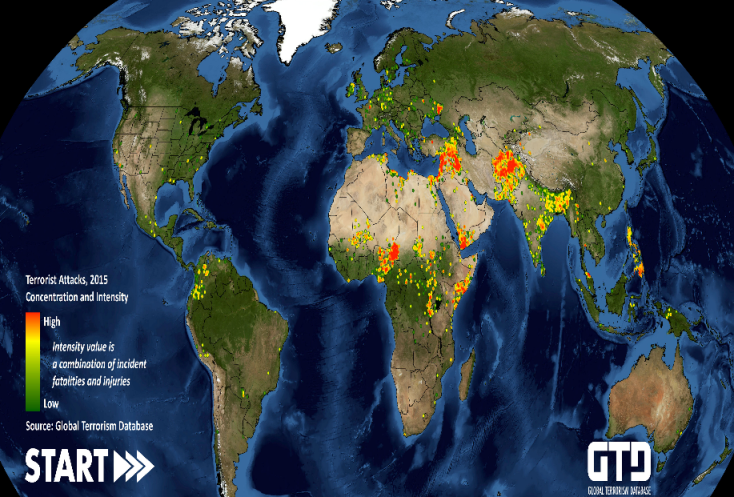 | Figure 1. Concentration and intensity of the terrorist attacks in 2015 in the world |
 | Figure 2. Attacks and deaths by region in 2015 |
3. Point Process
- The point process is a random collection of events which appears in some space and time. The Poisson process is the preliminary model of a point process where two consecutive events are independent. In other words, a point process is classified as a Poisson process if events occurring at two different times are statistically independent of one another which the characteristics by a single parameter or Poisson intensity. Some examples of certain events, incidence of disease, occurrences of fires, earthquakes, tsunamis [11], [12]. We consider the point process
 which that takes values on
which that takes values on  and the occurrences arrival times
and the occurrences arrival times  of each attack terrorism events. We say that a point process
of each attack terrorism events. We say that a point process  is orderly if for any time
is orderly if for any time 
 A point process is typically characterized by prescribing its conditional intensity
A point process is typically characterized by prescribing its conditional intensity  , which represents the infinitesimal rate at which events are expected to occur around a particular time
, which represents the infinitesimal rate at which events are expected to occur around a particular time  given the history of the process up to
given the history of the process up to  (Ogata, 1988) [14], denotes the history of events prior to time
(Ogata, 1988) [14], denotes the history of events prior to time 
 Notice that since the right hand side is a conditional expectation,
Notice that since the right hand side is a conditional expectation,  is a random variable. An important example of a point process is the Poisson process.
is a random variable. An important example of a point process is the Poisson process.  represents the number of events occurring between time
represents the number of events occurring between time  and
and  Given disjoint sets
Given disjoint sets  where
where is a Poisson process if the finite dimensional distributions
is a Poisson process if the finite dimensional distributions  each have a Poisson distribution and are independent. Notice that a Poisson process always has a deterministic conditional intensity
each have a Poisson distribution and are independent. Notice that a Poisson process always has a deterministic conditional intensity  If the process is stationary then
If the process is stationary then  is a constant.We say that a point process
is a constant.We say that a point process  is self-exciting if
is self-exciting if  for any
for any  This means that if an attacks terrorist event occurs, another event becomes more likely to occur locally in time and space. This is not the case for a Poisson process which it has independent increments so
This means that if an attacks terrorist event occurs, another event becomes more likely to occur locally in time and space. This is not the case for a Poisson process which it has independent increments so  . Although Poisson processes have many properties which make them particularly well suited for special purposes, they cannot capture interaction effects between events. So, for this reason we investigate in the next section, a specific class of point process noted a Hawkes Process.
. Although Poisson processes have many properties which make them particularly well suited for special purposes, they cannot capture interaction effects between events. So, for this reason we investigate in the next section, a specific class of point process noted a Hawkes Process.4. Hawkes and Self-exciting Point Process
- The Hawkes process is a simple point process, whose intensity function depends on the entire past history and is self-exciting and has the clustering property. The Hawkes process originally states that when an event occurs, it will increase the chance of occurrence of some future events. Over the past few years, Hawkes process models have received significant attentions from researchers, especially in natural phenomena such as seismology research in terms of theoretical and empirical implications. This process can be represented by the conditional intensity function:
 | (1) |
 is the normal counting measure (Hawkes & Oakes, 1974) [15] and
is the normal counting measure (Hawkes & Oakes, 1974) [15] and  is the baseline intensity or the rate of events,
is the baseline intensity or the rate of events,  denote the points, or event times, of the point process, and
denote the points, or event times, of the point process, and  is the excitation function. (Zhuang, Ogata, & Vere-Jones, 2002) [16]. The summation describes the self-exciting part of the process with the components
is the excitation function. (Zhuang, Ogata, & Vere-Jones, 2002) [16]. The summation describes the self-exciting part of the process with the components  and
and  represents the linear dependency over the past events. Many choices for the triggering density
represents the linear dependency over the past events. Many choices for the triggering density  have been used (Hawkes, 1971; Ogata, 1988) [3]. In the univariate model of the Hawkes process there is a response function we use an exponential distribution Egesdal et al. (2010) [17] that takes the form of the model (1):
have been used (Hawkes, 1971; Ogata, 1988) [3]. In the univariate model of the Hawkes process there is a response function we use an exponential distribution Egesdal et al. (2010) [17] that takes the form of the model (1): | (2) |
 before the exponential term is the normalization constant. In behavioral terms,
before the exponential term is the normalization constant. In behavioral terms,  corresponds to the strength of the drive to seek retribution for a previous attack, and
corresponds to the strength of the drive to seek retribution for a previous attack, and  represents the average time until a repeat event occurs. The intensity function of the univariate Hawkes process in the case of terrorism is usually used to predict the rate of attacks.The figure 3 indicates that a stationary background rate
represents the average time until a repeat event occurs. The intensity function of the univariate Hawkes process in the case of terrorism is usually used to predict the rate of attacks.The figure 3 indicates that a stationary background rate  is unrealistic for this reason we consider a non-stationary background rate
is unrealistic for this reason we consider a non-stationary background rate  Egesdal et al. (2010) [7], Ogata (1998) [14]. The simplest choice for a non-stationary
Egesdal et al. (2010) [7], Ogata (1998) [14]. The simplest choice for a non-stationary  is a step function parameterized by three values
is a step function parameterized by three values  and
and  So we obtain the following model:
So we obtain the following model: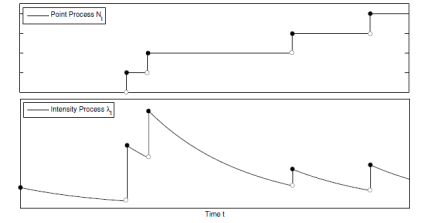 | Figure 3. Hawkes process with an exponential intensity |
 | (3) |
 We choose
We choose  and
and  based on visual inspection of where the largest jumps is occur and we consider the values of
based on visual inspection of where the largest jumps is occur and we consider the values of 
 and
and  are held constant while fitting the other model parameters.In this article the number of the attacks terrorist increase, for this we consider another model with a linear rate increase. In this case we obtain the following model:
are held constant while fitting the other model parameters.In this article the number of the attacks terrorist increase, for this we consider another model with a linear rate increase. In this case we obtain the following model: | (4) |
 For stationary, it is also assumed that
For stationary, it is also assumed that  By the above specification, we note in particular that the occurrence of an event will make the intensity process jump instantly by the amount
By the above specification, we note in particular that the occurrence of an event will make the intensity process jump instantly by the amount  which implies an increased chance of another event occurring in a short time interval following the event. This makes the self-exciting process an amenable model for recurrent event data with temporal clustering of events. In applications, two popular choices of the excitation function are the exponential decay function
which implies an increased chance of another event occurring in a short time interval following the event. This makes the self-exciting process an amenable model for recurrent event data with temporal clustering of events. In applications, two popular choices of the excitation function are the exponential decay function  with parameters
with parameters  and the polynomial decay function
and the polynomial decay function  with parameters
with parameters  and
and  With the corresponding constraints on the parameters, these two forms of the excitation function are both decreasing. From a practical point of view, it seems reasonable to assume that the residual excitation effect due to an individual event wears out and diminishes toward zero as time elapses. However, more specific assumptions, such as the exponential and polynomial forms, for the excitation function are not always justified. The terrorism attack model is a particular type of marked Hawkes process for modelling the number and the times of any attacks terrorism. We noted by
With the corresponding constraints on the parameters, these two forms of the excitation function are both decreasing. From a practical point of view, it seems reasonable to assume that the residual excitation effect due to an individual event wears out and diminishes toward zero as time elapses. However, more specific assumptions, such as the exponential and polynomial forms, for the excitation function are not always justified. The terrorism attack model is a particular type of marked Hawkes process for modelling the number and the times of any attacks terrorism. We noted by  the number of the attack occurring at time
the number of the attack occurring at time  The idea behind using the following model is that the terrorism attack is reflected in the fact that every new attack increases the intensity by
The idea behind using the following model is that the terrorism attack is reflected in the fact that every new attack increases the intensity by  For this reason the models (1), (2) and (3), (4) can be defined by:
For this reason the models (1), (2) and (3), (4) can be defined by: | (5) |
 are parameters, and the exponential density distribution is defined by
are parameters, and the exponential density distribution is defined by Equivalently we could define it by its conditional intensity function including both marks and times:
Equivalently we could define it by its conditional intensity function including both marks and times: | (6) |
 (Silverman, 1986) [21]. We use variable bandwidth kernel smoothing to construct a smoothed version of the data:
(Silverman, 1986) [21]. We use variable bandwidth kernel smoothing to construct a smoothed version of the data: Where
Where  We note by
We note by  the maximum of the
the maximum of the  nearest neighbor and by
nearest neighbor and by  the minimum bandwidth. We know that the rate
the minimum bandwidth. We know that the rate  represent the total of events for this we introduce the parameter
represent the total of events for this we introduce the parameter  So we obtain the following model:
So we obtain the following model:  | (7) |
 and
and  is affected by the choices of the
is affected by the choices of the  nearest neighbor and the bandwidth. To estimate the parameters, we use maximum likelihood estimation [19], [20]. We obtain for the linear model the log likelihood function:
nearest neighbor and the bandwidth. To estimate the parameters, we use maximum likelihood estimation [19], [20]. We obtain for the linear model the log likelihood function: We use the Akaike’s Information Criterion (AIC) to compare the models where the
We use the Akaike’s Information Criterion (AIC) to compare the models where the  [18] where
[18] where  is the number of parameters in the model and
is the number of parameters in the model and  is the maximum value of the likelihood function. Egesdal et al. (2010) [17] compare a self-exciting model to a stationary Poisson process with rate equal to the average number of events over the time interval in consideration. In the next section we estimate the parameters of the model by the likelihood method.
is the maximum value of the likelihood function. Egesdal et al. (2010) [17] compare a self-exciting model to a stationary Poisson process with rate equal to the average number of events over the time interval in consideration. In the next section we estimate the parameters of the model by the likelihood method.5. Inference Model
- There exist different method to estimate the parameters in a process specified by a conditional intensity function
 We apply the maximum likelihood inference or the Bayesian inference which we obtain a simplicity expression of the process. We consider the observed point
We apply the maximum likelihood inference or the Bayesian inference which we obtain a simplicity expression of the process. We consider the observed point  on an observation interval
on an observation interval  the likelihood function is given by:
the likelihood function is given by: Given a marked point
Given a marked point  the likelihood function becomes:
the likelihood function becomes:  By definition, the likelihood function is the joint density of all observed points
By definition, the likelihood function is the joint density of all observed points 

 appears since the unobserved next point for example
appears since the unobserved next point for example  must appear after the end of the observation interval. We assume that the conditional intensity function can be defined by the hazard function:
must appear after the end of the observation interval. We assume that the conditional intensity function can be defined by the hazard function:  And
And 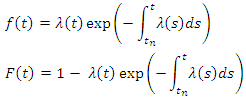 Where
Where  is the last point before
is the last point before  So we replace
So we replace  and
and  in
in  we obtain:
we obtain: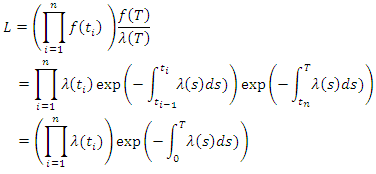 Where
Where  This result for the unmarked case. To obtain for the marked case, start by the factorization:
This result for the unmarked case. To obtain for the marked case, start by the factorization: Same demonstration in the unmarked case, we obtain:
Same demonstration in the unmarked case, we obtain: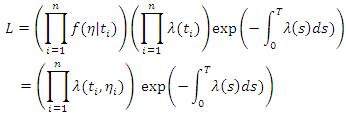 Which establishes the result for the marked case.Given the occurrence observations
Which establishes the result for the marked case.Given the occurrence observations  for an interval
for an interval  the log-likelihood of a point process with an intensity function
the log-likelihood of a point process with an intensity function  given in equation (1):
given in equation (1):  Where
Where  This is the familiar expression
This is the familiar expression  in the case of constant rate. The above log-likelihood is defined under the assumption that the occurrence observations are observed from time
in the case of constant rate. The above log-likelihood is defined under the assumption that the occurrence observations are observed from time  to a given time
to a given time  . However in most identification problems, only
. However in most identification problems, only  are given and
are given and  is not specified. We assume in this article
is not specified. We assume in this article  and
and  So the log -likelihood function for the specified intensity function is:
So the log -likelihood function for the specified intensity function is:  Exchanging the variables
Exchanging the variables  in the integrals we obtain:
in the integrals we obtain: Where
Where  By using the R software we can simulate the hawkes process and the likelihood function in the next section.
By using the R software we can simulate the hawkes process and the likelihood function in the next section.6. Simulation and Application to the Real Data
- The aim objective of this section is to verify the results of maximum likelihood estimates. The conditional Hazard function:
 So,
So, We assume the uniform random variable
We assume the uniform random variable  and we obtain:
and we obtain: Consider the expression in the above equation
Consider the expression in the above equation This can be written as
This can be written as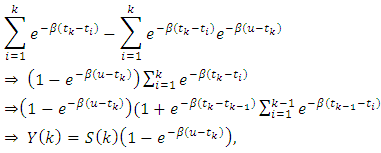 With
With  Hence one can solve the following equation:
Hence one can solve the following equation: And by using the following recursion we obtain:
And by using the following recursion we obtain: Where
Where  And
And  So, based on this recurrence equation we can simulate the Hawkes process with parameters
So, based on this recurrence equation we can simulate the Hawkes process with parameters  The originality of the Hawkes process application is explain in the rest of section. After originally being applied for earthquake prediction it has been also used to anticipate flash crashes in finance, epidemic type of behavior in social media such as Twitter and YouTube or criminality outbursts in big cities. So in this section we apply the Hawkes model to the terrorism events. Our empirical analysis relies on count data drawn from the Global Terrorism Database (GTD) for 1970–2015 [10]. We assume the background rate is stationary, and we compare that process to a stationary Poisson process through the AIC. The smoothed background rate model outperforms the other models with an AIC value of 801.1. By using the R software to apply Maximum Liklehood Estimator to estimate the parameters for the smoothed background rate model in equation (7), we obtain
The originality of the Hawkes process application is explain in the rest of section. After originally being applied for earthquake prediction it has been also used to anticipate flash crashes in finance, epidemic type of behavior in social media such as Twitter and YouTube or criminality outbursts in big cities. So in this section we apply the Hawkes model to the terrorism events. Our empirical analysis relies on count data drawn from the Global Terrorism Database (GTD) for 1970–2015 [10]. We assume the background rate is stationary, and we compare that process to a stationary Poisson process through the AIC. The smoothed background rate model outperforms the other models with an AIC value of 801.1. By using the R software to apply Maximum Liklehood Estimator to estimate the parameters for the smoothed background rate model in equation (7), we obtain  which means that every event causes between 1 more event on average, and
which means that every event causes between 1 more event on average, and  is the average time over which we expect an attack event to happen following a background event, in our case we have
is the average time over which we expect an attack event to happen following a background event, in our case we have  days which signifies we have about 17 days to arrive or prepare for another attacks. We have
days which signifies we have about 17 days to arrive or prepare for another attacks. We have  is equal to the number of events in the interval
is equal to the number of events in the interval  and
and  is an estimate for the number of background events in the data set which is about 83% of all the attacks terrorism in the MENA region. Based on Figure 6, we remark the trend form of the data, we remark that the stationary Poisson process is unlikely to give rise to our observed sequence of events. Rather use the AIC to evaluate the self-exciting model against a corresponding non-stationary Poisson model with self-excitation removed
is an estimate for the number of background events in the data set which is about 83% of all the attacks terrorism in the MENA region. Based on Figure 6, we remark the trend form of the data, we remark that the stationary Poisson process is unlikely to give rise to our observed sequence of events. Rather use the AIC to evaluate the self-exciting model against a corresponding non-stationary Poisson model with self-excitation removed  We note that the “black’ line represents the initial data set and the “red” line represents the predictive series which we can say the evolution of the terrorism events in the future. By using the SEISMIC software and the dataset (GTD) and the R package we can predict the attack terrorism which that increases the probability that you’ll have another attack which estimate the probability of future attacks at different times and in different areas.
We note that the “black’ line represents the initial data set and the “red” line represents the predictive series which we can say the evolution of the terrorism events in the future. By using the SEISMIC software and the dataset (GTD) and the R package we can predict the attack terrorism which that increases the probability that you’ll have another attack which estimate the probability of future attacks at different times and in different areas.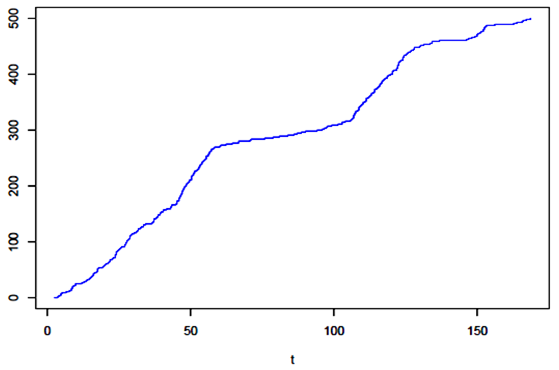 | Figure 4. Simulated trajectory of the Hawkes process |
 | Figure 5. Estimated intensity function |
 | Figure 6. Terrorism attacks between 1970 and 2015 |
7. Conclusions
- This paper presents the self-exciting model for the analysis and prediction of future terrorist activity. The improvement offered by the self-exciting term provides support for the contagion theory and suggests a significant short term increase in terrorism risk after an attack. The self-exciting hurdle model adheres to the theoretical concept for a contagion effect to terrorism as manifested in the clustering of data while providing good fit and predictive capabilities without relying on exogenous variables. The model provides a simple structure and interpretation of the parameters useful for understanding the dynamic nature of the terrorist activity. This provides an appropriate starting point for exploring additional covariate effects, including analysis concerning the effectiveness of counterterrorism activities, geography, political or economic factors. The utility of the models presented here and their ease of implementation and interpretation make them a potentially useful tool in security related fields. The results show that the risk of terrorist activity can vary greatly over short periods of time, thus policy responses in terms of resource allocation, security and counter-terrorism responses should reflect this as well as addressing the more long-term trends in risk.
 Abstract
Abstract Reference
Reference Full-Text PDF
Full-Text PDF Full-text HTML
Full-text HTML